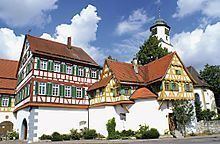 | ||
Fortress church
A fortress church (German: Kirchenburg) is particular type of church that, in addition to its religious functions is also used by the local population as a retreat and defensive position, similar to a refuge castle. A fortress church usually implies that the church is enclosed by its own fortifications, such as curtain walls and defensive towers. By comparison, a church with simple defensive features, such as battlements and embrasures on the church itself, is usually just referred to as a fortified church.
Contents
- Fortress church
- Architectural history
- Austria
- Baden Wrttemberg
- Bavaria
- Lower Saxony
- Thuringia
- Saxony
- Luxembourg
- Philippines
- Serbia
- Switzerland
- Romania Transylvania
- Literature
- References
Architectural history
The fortress church is typically surrounded by defensive walls equipped with wall towers and wall walks. It is a development of the fortified churches, whose defensive walls were also the actual walls of the church. However, the terms are often used interchangeably and there is often no clear distinction. However, generally a fortified church is a single building, whereas a fortress church is a building complex.
In the Early Middle Ages, former bishop's seats, especially in recently Christianised regions like Saxony, were designed as fortress churches. There they were referred to as a Domburg or "cathedral castle".
Fortress churches are especially common in Franconia, South France and Transylvania. Particularly in Transylvania, a historic German settlement area in Romania, there are well over a hundred fortress churches, of which seven have been designated as UNESCO World Heritage Sites (Birthälm/Biertan in 1993, Kelling/Calnic, Wurmloch/Valea Viilor, Dersch/Darjiu, Deutsch-Weißkirch/Viscri, Keisd/Saschiz and Tartlau/Prejmer in 1999). They were built and maintained in order to defend against successive Turkish invasions.
The fortress churches surviving today date from the 15th century. Unlike the populations of towns and cities, villagers did not have the money to build defences around the whole settlement. They were no less vulnerable, however, to the military conflicts of their overlords and the associated raids and plundering. Large bands of marauders were also a danger not to be underestimated. The church was often the only stone building in the village and was, at least, best suited for defence. As a result, the various forms of defensible church appeared, from those surrounded by barns in which a siege of several days could be endured to a fortified cemetery (Wehrfriedhof), to simple fortified churches and, finally, the fortress church.
Fortress churches have not survived in North Germany. This is probably because the stone curtain walls were later dismantled in this area, in which there is a scarcity of stone, in order to be re-used for other purposes. The only well-known fortress church in the coastal region is the Church of St. Dionysius in Bremerhaven-Wulsdorf, which is recorded as having a field stone curtain wall up to 3.60 metres high.
Austria
Baden-Württemberg
Bavaria
County of Kulmbach
County of Eichstätt:
County of Bad Kissingen:
Landkreis Cham
County of Erlangen-Höchstadt
County of Forchheim:
County of Haßberge:
County of Kitzingen:
County of Main-Spessart:
County of Miltenberg:
County of Neustadt/Aisch – Bad Windsheim:
County of Rhön-Grabfeld:
County of Schweinfurt:
County of Würzburg:
County of Passau:
City of Nuremberg:
Lower Saxony
County of Osnabrück:
Thuringia
County of Hildburghausen:
County of Schmalkalden Meiningen:
Saxony
County of Görlitz
Luxembourg
Philippines
Serbia
Switzerland
Romania (Transylvania)
Among the dozens of well-preserved fortified churches in Transylvania (present day Romania), seven of them are located in the UNESCO World Heritage Site inscribed in 1993 as the villages with fortified churches in Transylvania.
